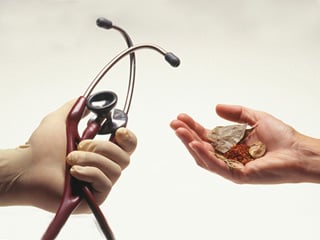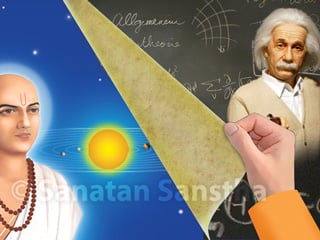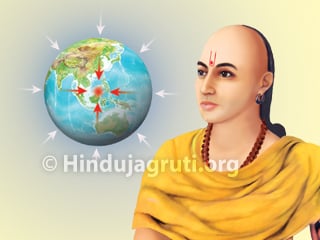Ancient Indian medicine and its alternative therapeutic practices : an Introduction
Alternative therapies refer to a broad group of natural and spiritual healing methods that are different than the conventional western medicine (or pharmaceutical medicine). Many of these healing methods have been used for centuries in many different cultures. A few examples are Ayurveda, Acupuncture, Aromatherapy, Herbal therapy, Meditation, Naturopathy, Traditional Chinese Medicine (TCM), etc.
Though Ayurveda is perhaps 5,000 years old, the West has finally woken up now to the possibilities of its efficacy. Not only more people, but even celebrities such as Madonna, Naomi Campbell and Demi Moore, are turning to India’s ancient science to be cured of their ailments. Gopi Warrier, who is the first founder of Britain’s Ayurvedic Charitable Hospital and whose family has run Ayurvedic hospitals in south India for many generations, says, “western medicine has failed to deal with chronic problems as well as new, antibiotic-resistant bacteria, and Ayurveda, by contrast, has an excellent record of curing the sort of chronic problems that do not respond well to western medicine. Whether it is enzema, cystitis or migraines, Ayurveda can get to the root of the problem.” As the Western medical practices did not satisfy the people, they have shifted their attention to alternative medicine systems. According to Dr David Eisenberg who is working at the Centre for Alternative Medicine at Harvard, the Americans show a willingness to spend billions on alternative medicine to experiment and explore all possible avenues.
In the world of medicine, Ayurveda represent a very effective alternative system of medicine with its remarkable therapies like oil massage therapy, magnetic therapy, hot treatment therapy, mud therapy, herbal therapy, magical therapy, music therapy, etc. All over the world people have developed alternative medical hospitals where Ayurveda is widely practiced, and very successfully. Gopi Warrier first introduced the Ayurvedic clinic in London in 1988, and around the same time the first Maharishi Ayur-Veda Health Centre was established in Britain. In 1996, Dr. Shanta Godagama, from Sri Lanka, set up the Ayurvedic Medical Centre at the Hale Clinic in London; these are few prestigious centers for alternative medicines. According to a study, the global herbal market is worth $120 billion a year and Ayurveda’s share is $60 billion a year.
In India, at AIIMS (All India Institute of Medical Science) now it is compulsory to follow these traditional alternative therapies along with their western treatments. According to Dr. Upendra Singh, professor and head of department of physical medicine and rehabilitation at AIIMS, “Heat therapy is being widely used as a method of treatment as it relieves pain and also gives a sense of well being”. Dr. Neelkanth Goswami of Delhi’s Northern Railway Central Hospital defines music therapy as a way of maintaining and improving the mental health of an individual. In 1930s Electro Convulsive Therapy was developed in the field of psychiatric disorders, but currently this therapy is totally rejected by many modern doctors, but Dr. Rajesh Sagar of the psychiatry department of AIIMS says, “Traditionally, electric shocks are viewed as barbaric but they are the best effective method of treatment for acute depression”.
Ancient indian medcine and alternative Therapies
There are many Indian traditional therapies, which are practiced by many Indian tribes and rural people that are more effective in many incurable diseases, like migraine, insomnia, mental disorders, sinusitis, asthma, indigestion, arthritis, spondylitis, sciatica, paralysis, eczema, substance abuse, viral infection, generally ill health, etc. A few therapies I have described below.
Oil Massage Therapy or Kerala Ayurveda (Dhara)
Oil massage therapy or Dhara traces its roots back to 3000 years. This therapy is generally practiced by the Kerala’s people. Many centers are established in Kerala these days, which provide this therapy. Basically this therapy is a cure for a variety of physical and mental diseases, strains and tensions, arthritis, spondylitis, paralysis, obesity, sinusitis, migraine, rheumatism, etc.
The treatment called Panchkarma is based on the principal of Tridosha (three faults), which are Vata, Pitaand Kapha. The name panchkarma comes from two Sanskrit words, Pancha meaning five and Karma meaning action or process. Through this five-fold purification therapy healers revive the disturbed equilibrium of these three doshas. Panchkarma therapy has three main stages: poorvakarma, pradhanakarma and paschatkarma. Poorvakarma is the first stage that comprises essential preliminary procedures preparing the body to unload stored toxins. Pradhanakarma is the second stage and main cleaning therapies. Paschatkarma is the final stage and describes the measures employed after the main treatment.
Magnetic Therapy
The word magnetic therapy comes from the magnet. In this process, the different positive forces of a magnet are taken into account to cure any kind of diseases. In the Atharvaveda words like ‘sikata‘ and ‘ashman‘ were used which mean ‘sand’ and ‘stone’ respectively. These two elements were effectively used to counter ravages, wrought by bleeding and for countering infertility among women. Ceramic magnetic devices owe their origin to the above two elements, in conjunction with iron.
Healing magnets of about 200 gauss are considered to be of lower powers and are meant to be used on sensitive and delicate organs and diseases appearing therein like tonsils, eye, nose, etc.
Mud Therapy
Mud therapy is regarded as 1000 years old traditional Indian Ayurvedic medicine in which different layers of mud paste are applied on the body against diseases. Basically Indian rural and tribal people believe that mud has many medical properties for all kinds of diseases. They smear mud on the inner and outer layer in their houses to keep it cool during summer and warm during winter, and most importantly, to keep diseases and germs outside the houses.
This is the best treatment of many incurable diseases such as migraine, insomnia, mental disorders, sinusitis, asthma, indigestion, arthritis, spondylitis, sciatica, paralysis, eczema, viral infection, general ill health, etc.
Mud therapy as enunciated by Ayurveda, is based on the principal of two elements, prithvi (earth) andvayu (air). Mud from various places has different medical properties like soil of the northern hills are very good for arthritis, spondylitis, sciatica and paralysis; mud of the desert is good for viral infection. The mud of south India has the most effective properties against many diseases, as it is rich in minerals. It is believed that the concept of mud therapy originated from south India, and I think this therapy is deeply connected with Sidha medicine system because Sidha is essentially mineral based Indian traditional medicine system.
Agnikarma or Tau-dam
Tau-dam is a basically a traditional Himalayan therapy practiced by the rural Himalayan people for liver troubles, stomach troubles, backache, etc. According to Tewari (2002), this therapy was also practiced by the ancient people and is also mentioned in Ayurveda as agnikarma. He mentions that in other parts of India also this therapy is used for stomach and liver troubles.
Tau therapy is generally practiced by the older people of village and is compulsory for 6 month to 1-year old children. A 45-60 cm long iron rod is called the tau, which is sharply curved at one end and has one or two holes depending upon the diseases. In this therapy, tau device is placed on burning fire till it gets red-hot. The older people touch this red-hot tau on the affected skin for only a few seconds. And after branding it, they massage the affected area with the mustard or olive oil.
In the dam technique, fresh seeds of Terminalia chebula or Anaphalis araneosa are burned on fire and touched on the required part of the body for only few seconds. After this, like tau, the effective area is massaged with the mustard or olive oil.
Generally this therapy is practiced in the month of April because, according to Ayurveda, this is very suitable time for treatment of the vata, pitta and kapha.
Magical Therapies
As most of the Indian people believe that diseases are the result of the wrath of gods, they treat diseases through magical therapies, like zadu tona, tantra mantra, jhar phuk, etc.
In the Central Himalayan region a magical therapy is practiced very widely against diseases. This magical therapy is very ancient and called jagar. According to the Himalayan people this is the best cure for many incurable diseases, especially mental and psychiatric diseases. Jagar is held at night and takes one night or twenty-two nights depending upon the severity of the wrath of the local god.
On a specific day the prayer room of the patient’s house is cleaned and provided with articles of worship such as fruit, cereals, milk, ghee, sweets, etc. The floor of house is coated with the mixture of red soil and cowdung and decorated with flowers, etc. At night patients and his family members, relatives, friends, thejagaria (hymn chanter and conductor of the ceremony) and the dangaria (the dancer who acts as a mediator between god and jagaria). At first the jagaria chants the devi strot and prays to the patient’s household god and sprinkles the ganga jal (river water). After this a crude drum (hurkha or nagara) and a metallic plate (thali) are played, the jagaria chants hymns, and the dangaria begins to dance. When the dance and the music reach their peak, the patient’s household god speaks through the medium of thedangaria. The relatives ask the god-in-medium the cause of his anger. He tells the cause, which could be that the patient did not worship him properly, or that he did not offer the god sufficient share from his earnings, etc. As a penalty the god may demand a simple khichari (a mixture of uncooked rice, urad, chillies, and salt), or a sacrifice of a goat, pig, cock, or coconut, or a continuous Jagar for 20 days or so, or simple worship at home or in a particular temple; it also depends on the caste of the patient whether he is a brahman, a thakur, or a dom, etc. Everyone has to fulfill the demands of the god because failure to do so may result in serious consequences, not only to the patient but also to his family. About 50% of the patients are cured by it. This medical therapy is psychosomatic in nature and needs to be properly investigated.
Herbal Therapies
Basically, Ayurveda is a herbal medicine system and it cures many incurable diseases. These herbal products are used in the form of powder, decoction, tonic, etc. These could be a single herb or a mixture of many herbal products, depending on the diseases and the treatment required.
The use of herbal products for treatment in India dates back to prehistoric times. In the Indus Valley Civilization tree worship was a very remarkable feature, which shows the importance of plants and plant products in human life. In Vedic times, Rgveda mentions a few plants like Semal, Pithvam, Palash, Pipal, etc. These references increased in the later works, like Atharvaveda. The Kalpasutra of Atharvaveda refers to an exhaustive list of 579 plants and mentions their botanical characteristics and medical properties.
Today, Ayurveda has captured more than 50% part of the world’s herbal market. A recent survey shows that the global herbal market is worth $120 billion a year and Ayurveda represents $60 billion of it. According to market experts the global herbal market is expected to grow to Rs. 2,50,000 crore by 2010.
Yoga
Yoga is a comprehensive term comprising yogasanas, breath control, meditation, etc. The word Yoga in Sanskrit means to link, to unite and its ultimate goal is to achieve a reunion of our soul (jeevatma) with the supreme soul (paramatma). The main aim of yoga is to build physical and mental powers in a human body.
Yogasanas or asanas form only a part of yoga and are meant to keep the body in good health. Recent scientific research and experiments have proved beyond doubt the efficacy of yoga in controlling and curing many serious diseases like blood pressure, heart diseases, hypertension, nervous disorders, etc.
Other Therapies
Talam: A herbal paste mixed with oil is applied to the head. This cures insomnia, improves eyesight, cures skin disorders and headache.
Chakra Basti: This treatment is used for curing indigestion and alleviates constipation. The umbilical region is bathed with medicated oil or herbal decoctions.
Greeva Basti: Bathing the back of the neck with warm medicated oil or herbal decoction. It cures the cervical spondylosis and chronic pain in the neck region.
Conclusion
We thus observe that the people are shifting their allegiance to the Indian alternative therapies, because these therapies are natural and have no side-effects. The western medicine has failed to deal with the chronic diseases as well as new, antibiotic-resistant bacteria. Ancient therapies, by contrast, have an excellent record of curing the chronic diseases that do not respond well to western medicine.
Sources
Bright, P. S. 2000. India’s alternative therapies: the cure of modern times. Junior Science Refresher, November: 20-27.
Stock Jon. 2002. Ayurveda goes global. The Week, July 28: 16-27.
Tewari, V. P. 2002. Uttaranchal ki paramparik chikitsa paddhati: tau-dam (in Hindi). In press.
2002. The healing touch….. The Times of India, Delhi Times “Health and Fitness“.
Varupi Jain. 2001. Fast forward to the past. The Saturday Statesman “Life Style“, October 20: 2.
Shah, N. C. and M. C. Joshi. 1971. An ethnobotanical study of Kumaun region of India. Economic Botany, 25(4): 414-422.
Source : IndianScience


 History of Indian Science
History of Indian Science Indian Astronomy Through Ages
Indian Astronomy Through Ages